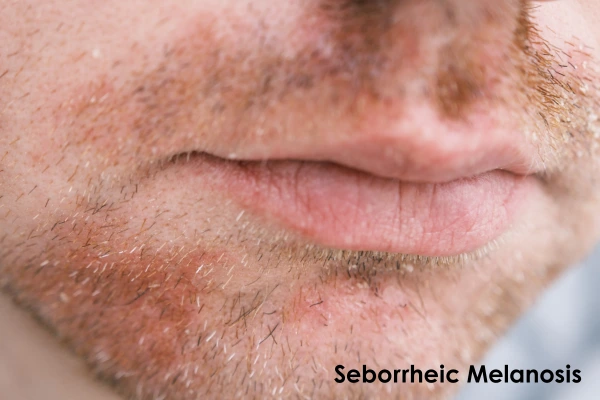Up to 25% OFF on Selected Treatments
-
Treatments
Acne and Scar
Pigmentation
Laser Hair Reduction
Dermato-surgery
Body
Anti Aging
Skin Rejuvenation
Others
- Clinics
- Blogs
Treatments
Have you noticed small, dark, flat patches on your skin, particularly on your face, nose, mouth, chest, or back? You may be experiencing seborrheic melanosis. These patches seem persistent and leave you to know their causes and effective ways to treat them. If you are in the same situation, then you are not alone. Many people struggle to deal with this skin condition that affects the most visible part of your identity—your face. But what is seborrheic melanosis, and how can you restore your skin’s natural glow, and what are all the advanced seborrheic melanosis treatment options available? This blog provides you with all the information you need about this skin condition, including its causes, symptoms, and dermatologist-approved treatments to achieve even and healthy skin.

It is a prevalent, non-cancerous skin condition characterized by dark brown or grayish patches, often found on the face, particularly around the nose, lips, mouth, or forehead. Unlike hyperpigmentation, seborrheic melanosis is more common in individuals with seborrheic dermatitis, a chronic condition that affects oily areas of the skin and darker skin tones.
This condition can be quite frustrating and may also affect your self-esteem. These patches are not just cosmetic issues; they can indicate underlying dermatological problems that require professional attention.
Here’s a closer look at the common triggers:

How do you identify that you have this skin condition? Check out these signs and symptoms:
Characteristics
Nowadays, the internet shows overwhelming skin care products and tips to get rid of this skin condition—seborrheic melanosis—but it can lead to delayed treatment. A professional consultation with Evenly Clinic ensures a precise diagnosis and tailored treatment solution.
Our skilled dermatologists assess your skin’s specific requirements, ruling out conditions such as melasma or post-inflammatory hyperpigmentation to provide targeted solutions.
As this skin condition is harmless, it doesn’t require treatment. But if it appears on your face, it steals your beauty. Many people seek seborrheic melanosis treatment for cosmetic reasons, especially when it is present on the face, around the mouth, and on the nose. Let’s explore the treatment options available at Evenly Clinic:
To address the fungal component of seborrheic dermatitis and reduce inflammation and discoloration, our dermatologist may prescribe antifungal creams and ointments. These creams include clotrimazole and ketoconazole, along with corticosteroids.
They may also prescribe topical medications that contain skin-lightening agents to target pigmentation and reduce the appearance. Topical creams include kojic acid, hydroquinone, azelaic acid, and retinoids.
Chemical peels can help exfoliate the top layer of skin, revealing a more youthful and even-toned complexion.
Laser treatment targets the pigmented cells and breaks them down, leading to a reduction in the appearance of dark patches. It helps lighten the seborrheic melanosis.
Must Read: Laser Toning: Unlock Flawless Skin & Say Goodbye to Hyperpigmentation
If you are concerned about seborrheic melanosis on your face, around your mouth, or on your nose, it is essential to consult an experienced dermatologist for an effective treatment. They accurately diagnose the skin condition and prepare a tailored treatment plan.
Seborrheic melanosis around the mouth can be effectively treated with dermatologist-approved treatments like topical creams, chemical peels, and laser treatment.
Must Read: Chemical Peel for Hyperpigmentation: How It Works and Benefits
Seborrheic melanosis on the nose often requires similar treatments to address pigmentation effectively. Options include:
It is a benign skin condition that often appears as dark patches on the face. Even though it’s harmless, many find it to be an aesthetic concern. With the right guidance and dermatologist-approved treatments, you can take proactive steps and minimize the appearance of these dark patches and restore your skin’s natural glow. At Evenly Skin and Hair Clinic, we’re here to help you achieve your skincare goals.
If you have any questions or concerns about seborrheic melanosis, consult with a dermatologist for personalized advice and treatment.
Your journey to flawless and even skin starts here!!!
For health-related information, follow us on Instagram!!
Click here for an online consultation!!
Is seborrheic melanosis the same as melasma?
No, this skin condition is not the same as melasma. It is associated with seborrheic dermatitis, while melasma is usually triggered by hormonal changes or sun exposure.
Where does seborrheic melanosis usually appear?
It typically shows up on the face, especially around the nose, mouth, forehead, and occasionally on the scalp.
Is seborrheic melanosis permanent?
No, it is not a permanent condition. With appropriate treatments like topical creams, chemical peels, or laser treatment, it can be effectively managed.
Can seborrheic melanosis spread?
The skin condition doesn’t spread like an infection, but it can manifest in various areas due to factors such as oil production or inflammation.
Is seborrheic melanosis contagious?
No, it is not contagious and cannot be transmitted from one person to another.
Is seborrheic melanosis painful or itchy?
The condition itself isn’t painful or itchy, but the associated seborrheic dermatitis may cause some discomfort.
Can seborrheic melanosis affect all skin types?
Yes, it can affect all skin types, although those with oily skin might be more susceptible to it.
We hope this information is helpful. If you have any skin and hair-related questions or would like to discuss personalized solutions, please reach out to us at 7337899030. Our team of specialists is committed to delivering personalized care tailored to your specific needs. Take the first step towards a healthier, more confident you by scheduling a consultation with us today. Your journey to vibrant skin and stronger hair begins here.
Book an Appointment
Start your journey to healthy skin and hair today.
Leave a Comment